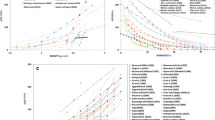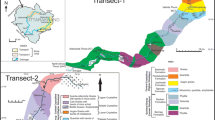Abstract
The aim of this study was to develop and evaluate statistical models for predicting the uniaxial compressive strength (UCS) and average Young’s modulus (E av) for caliches, using some index and physical properties. The caliche samples, from Adana, southern Turkey, were of low strength and difficult to sample. X-ray diffraction and microscopy were undertaken and the following physical parameters established: unit weight, apparent porosity, Schmidt rebound number, Shore hardness, P-wave velocity, slake durability, point load, uniaxial compressive strength and average Young’s modulus. Simple and linear regression variable selection analyses were performed. The best relationships were obtained for UCS with P-wave velocity and unit weight and for average Young’s modulus with P-wave velocity, porosity and slake durability. Empirical equations are proposed, although it is emphasised that these may only be applicable for caliche of a similar geological character.
Résumé
Le but de cette étude est d’établir et d’évaluer des modèles statistiques permettant de prédire la résistance à la compression simple et le module d’Young de calcrètes à partir de quelques indices et propriétés physiques. Les échantillons de calcrètes d’Adana, dans le sud-est de la Turquie, présentent de faibles résistances et leur échantillonnage est difficile. Des analyses par diffractométrie RX et des observations microscopiques ont été réalisées. Les paramètres physiques suivants ont été déterminés: poids spécifique, porosité, indice de rebond de Schmidt, dureté Shore, vitesse des ondes P, indice d’altérabilité, résistance à l’écrasement entre pointes, résistance à la compression simple et module d’Young. Des analyses de régression linéaire entre ces paramètres ont été réalisées. Les meilleures relations ont été obtenues pour la résistance à la compression simple fonction de la vitesse des ondes P et du poids spécifique et pour le module d’Young fonction de la vitesse des ondes P, de la porosité et de l’indice d’altérabilité. Des équations empiriques ont été proposées, tout en soulignant que ces équations ne sauraient être utilisées que pour des calcrètes aux caractéristiques géologiques semblables.













Similar content being viewed by others
References
Aggistalis G, Alivizatos A, Stamoulis D, Stournaras G (1996) Correlating uniaxial compressive strength with Schmidt hammer rebound number, point load index, Young’s modulus, and mineralogy of gabbros and basalts (Northern Greece). Bull Eng Geol 54:3–11
Aufmuth ER (1973) A systematic determination of engineering criteria for rocks. Bull Assoc Eng Geol 11:235–245
Beverly BE, Schoenwolf DA, Brierly GS (1979) Correlations of rocks index values with engineering properties and the classification of intact rocks
Bieniawski ZT (1974) Estimating the strength of rock materials. J S Afr Inst Min Metall 74:312–320
Çobanoğlu I, Bozdağ Ş, Kumsar H (2008) Microstructural, geochemical and geomechanical properties of caliche deposits from the Adana Basin, Turkey. Bull Eng Geol Environ (in press)
Davis JC (1986) Statistics and data analysis in geology. Wiley, Canada
Deere DU, Miller RP (1966) Engineering classification and index properties for intact rocks. Tech Rep Air Force Weapons Lab, New Mexico, no AFNL-TR, pp 65–116
Dinçer İ, Acar A, Çobanoğlu İ, Uras Y (2004) Correlation between Schmidt hardness, uniaxial compressive strength and Young’s modulus for andesites, basalts and tuffs. Bull Eng Geol Environ 63:141–148
Fahy MP, Guccione MJ (1979) Estimating strength of sandstone using petrographic thin-section data. Bull Assoc Eng Geol 16:467–485
Ghose AK, Chakraborti S (1986) Empirical strength indices of Indian coals–an investigation. In: Proceedings of 27th US symposium on rock mechanics, Balkema, Rotherdam, pp 59–61
Goudie PA, Pye K (1983) Chemical sediments and geomorphology. Academic Press, London, pp 93–131
Gökçeoğlu C (1996) Schmidt sertlik çekici kullanılarak tahmin edilen tek eksenli basınç dayanımı verilerinin güvenirliği üzerine bir değerlendirme (in Turkish). Jeol Müh Dergisi 48:78–81
Gunsallus KL, Kulhawy FHA (1984) Comparative evaluation of rock strength measures. Int J Rock Mech Min Sci Geomech Abstr 21:233–248
Haramy KY, DeMarco MJ (1985) Use of Schmidt hammer for rock and coal testing. In: Proceedings of 26th US symposium on rock mechanics, 26–28 June, Rapid City, pp 549–555
Horta JC (1980) Calcrete, gypcrete and soil classification in Algeria. Eng Geol 15:15–52
IAEG (1979) Report of the commission on engineering geological mapping. Bull IAEG 19:364–371
ISRM (International Society for Rock Mechanics) (1978a) Commission on Standardization of Laboratory and Field results. Suggested Methods for Determining Hardness and Abrasiveness of Rocks. Int J Rock Mech Min Sci Geomech Abstr 15:89–97
ISRM (International Society for Rock Mechanics) (1978b) Suggested Methods for Determining Sound Velocity. Int J Rock Mech Min Sci Geomech Abstr 15:53–58
ISRM (International Society for Rock Mechanics) (1979) Commission on Standardization of Laboratory and Field Tests, Suggested Methods for Determining Water Content, Porosity, Density, Absorption and Related Properties and Swelling and Slake Durability Index Properties. Int J Rock Mech Min.Sci 16:148–156
ISRM (International Society for Rock Mechanics) (1981a) Rock Characterization Testing and Monitoring, ISRM Suggested Methods. International Society for Rock Mechanics, 211 pp
ISRM (International Society for Rock Mechanics) (1981b) Suggested Methods for Determining Hardness and Abrasiveness of Rocks, part 3. Commission on Standardisation of Laboratory and Field Tests, pp 101–102
ISRM (International Society for Rock Mechanics) (1981c) Suggested Methods for Determining the Uniaxial Compressive Strength and Deformability of Rock Materials. International society for rock mech. Commission on Standardisation of Laboratory and Field Tests, pp 111–116
ISRM (International Society for Rock Mechanics) (1985) Suggested Methods for Determining Point-load Strength. Int J Rock Mech Min Sci 22:53–60
Kahraman S (1996) Basınç direnci tahmininde schmidt ve nokta yük indeksi kullanmanın güvenirliği. In: Korkmaz ve S, Akçay M (eds) KTÜ Jeoloji Mühendisliği Bölümü 30. Yıl Sempozyumu Bildiriler Kitabı, Trabzon, pp 362–369 (in Turkish)
Kahraman S (2001) Evaluation of simple methods for assessing the uniaxial compressive strength of rock. Int J Rock Mech Mining Sci 38:981–994
Kapur S, Yaman S, Gökçen SL, Yetiş C (1993) Soil stratigraphy and Quaternary caliche in the Misis area of the Adana basin, southern Turkey. Catena 20:431–445
Karakuş M, Kumral M, Kılıç O (2004) Predicting elastic properties of intact rocks from index tests using multiple regression modeling (Technical note). Int J Rock Mech Mining Sci 42:323–330
Katz O, Reches Z, Roegiers JC (2000) Evaluation of mechanical rock properties using a Schmidt hammer. Tech Note Int J Rock Mech Min Sci 37:723–728
Kindybinski A (1980) Bursting liability indices of coal. Int J Rock Mech Min Sci Geomech Abstr 17:167–161
Koncagül EC, Santi Paul M (1999) Predicting the unconfined compressive strength of the Breathitt shale using slake durability, Shore hardness and rock structural properties. Int J Rock Mech Mining Sci 36:139–153
Miller RP (1965) Engneering classification and index properties for intact rock. PhD Thesis, University of Illinois
O’Rourke JE (1989) Rock index properties for geo-engineering in underground development. Min Eng 106–110
Sachpazis CI (1990) Correlating Schmidt hammer rebound number with compressive strength and Young’s modulus of carbonate rocks. Bull Int Assoc Eng Geol 42:75–83
Shakoor A, Bonelli RE (1991) Relationship between petrographic characteristics, engineering index properties and mechanical properties of selected sandstones. Bull Assoc Eng Geol 28:55–71
Shorey PR, Barat D, Das MN, Mukherjee KP, Singh B (1984) Schmidt hammer rebound data for estimation of large scale in-situ coal strength (Tech Note). Int J Rock Mech Min Sci Geomech Abstr 21:39–42
Singh RN, Hassani FP, Elkington Pas (1983) The application of strength and deformation index testing to the stability assessment of coal measures excavations. In: Proceedings of 24th US symposium on rock mechanics, Texas A&M Univ, AEG, pp 599–609
Wright VP, Tucker ME (1991) Calcretes. IAS Repr Ser, vol 2. Blackwell, Oxford, 352 pp
Xu S, Grasso P, Mahtab A (1990) Use of Schmidt hammer for estimating mechanical properties of weak rock. 6th Int IAEG Congress. Balkema, Rotterdam, pp 511–519
Yaşar E, Erdoğan Y (2004a) Correlating sound velocity with the density, compressive strength and Young’s modulus of carbonate rocks (Technical Note). Int J Rock Mech Mining Sci 41:871–875
Yaşar E, Erdoğan Y (2004b) Estimation of rock physicomechanical properties using hardness methods. Eng Geol 71:281–288
Yılmaz I, Sendir H (2002) Correlation of Schmidt hammer rebound number with unconfined compressive strength and Young’s modulus in gypsum from Sivas (Turkey). Eng Geol 66:211–219
Yılmazer I, Smith I (1992) Yumuşakken ve sertken seviyelerinden oluşan kalişin jeolojik ve jeoteknik özellikleri (in Turkish). Türkiye jeoloji kurultayı Bülteni S7:145–152
Zorlu K, Kasapoğlu KE (2004) Adana yöresindeki kalişlerde iç yapı çökme potansiyelinin tahminine yönelik görgül bir yaklaşım (in Turkish). Hacettepe Üniversitesi Yerbilimleri Dergisi 29:133–141
Acknowledgments
This study was supported by TÜBİTAK (Project No: 104Y189). The authors would also like to thank the Çukurova University Scientific Research Project Unit for providing financial support (Projects No: MMF-2004BAP-11 and MMF-2004D-19).
Author information
Authors and Affiliations
Corresponding author
Rights and permissions
About this article
Cite this article
Dinçer, İ., Acar, A. & Ural, S. Estimation of strength and deformation properties of Quaternary caliche deposits. Bull Eng Geol Environ 67, 353–366 (2008). https://doi.org/10.1007/s10064-008-0146-1
Received:
Accepted:
Published:
Issue Date:
DOI: https://doi.org/10.1007/s10064-008-0146-1




